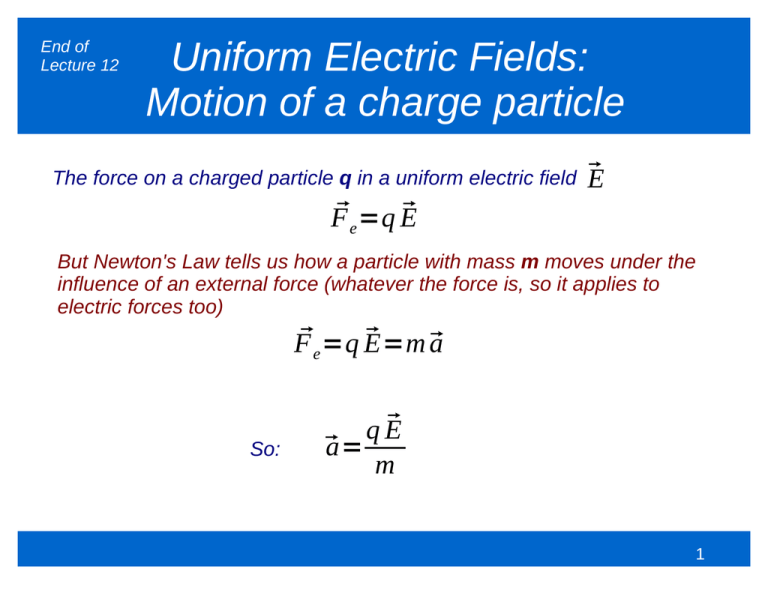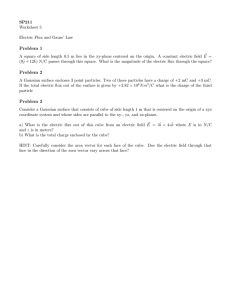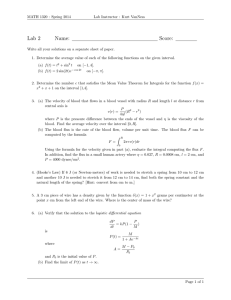Uniform Electric Fields & Electric Flux Presentation
advertisement

End of Lecture 12 Uniform Electric Fields: Motion of a charge particle The force on a charged particle q in a uniform electric field E Fe =q E But Newton's Law tells us how a particle with mass m moves under the influence of an external force (whatever the force is, so it applies to electric forces too) =m Fe =q E a So: qE a = m 1 Electric Field Lines: Questions Electric field lines from a point positive charge point outward. Electric field lines from a point negative charge point inward. q E + In which direction will the charge move? 2 Uniform Electric Fields: Motion of a charge particle qE i a =a i= m We chose our field along the positive x direction. We can apply all the kinematics we have learnt. x E q + 1 2 x f = x iv i t a t 2 and v f =v ia t and v f 2=v i22 a x f x i 3 Uniform Electric Fields: Motion of a charge particle Lets assume the particle starts at rest, And the final position v i=0 and at x i=0 x f= x x q E + qE x v f =2 a x f =2 m 2 and the kinetic energy 1 2 K = m v f =qE x 2 4 Lecture 13 Motion of a Charge in Electric Fields Lets do another kinematics problem with electrostatic forces. Consider a uniform electric field E= E0 j The electrostatic force on a charge: Fe=q E An electron has charge -e Fe=e E ------------------------- E0 +++++++++++++++++++++++++++ L What is the speed of the electron when it exits the metal plates? 5 Motion of a Charge in Electric Fields We have initial speed and length of the region with the field. ------------------------- Initial velocity is along x vi=v i i - Acceleration is Force/Mass E0 Fe j e E = a= me me ax =0 and ++++++++++++++++++++++++++ eE ay = me L Work the rest out in class 6 Electric Flux Electric flux is a quantity that is proportional to the number of field lines passing though a given area. This is a loose definition. We will make this definition more concrete. The concept of electric flux is very important. It will lead us to the most important result in electrostatics: by looking at the electric flux through a closed surface, you can tell how much charge is enclosed within it 7 Electric Flux Step 1 Define a surface normal to an element of area. Consider this cube. It has 6 surfaces: 1 and 2 (left and right) 3 and 4 (top and bottom) 5 and 6 (front and back) The surface normal is a unit vector that is perpendicular to the surface. If the surface is closed (like this cube) the unit vector always points outward. 3 1 2 5 4 8 Electric Flux Step 2 If the surface normal is parallel to the direction of the electric field, then the flux through an area A is E =E A A n E E 9 Electric Flux Step 2 If the surface normal is at an angle the direction of the electric field, then the flux through an area A is E =E Acos A E n E 10 Electric Flux Step 3 How to deal with curved surfaces ? Define an infinitesimal area dA n dA dA= The flux through this area is E . n dA d E= E. dA= E dA 11 Electric Flux Step 4 To get the flux through the entire area we must integrate over the entire surface The total electric flux over the entire curved surface is: E =surface E. dA dA E. n = surface E dA 12 Electric Flux Through A Closed Surface Lets break this down into three cases: 1. surface whose normals are at angles between -/2 and /2 with respect to the electric field direction. 2. surface whose normals are at an angles of /2 with respect to the electric field direction. 3. surface whose normals are at angles between /2 and 3 2 with respect to the electric field direction. dA E 13 Electric Flux Through A Closed Surface Lets break this down into three cases: 1. surface whose normals are at angles between - /2 and /2 with respect to the electric field direction. E. dA=E dAcos 0 dA E 14 Electric Flux Through A Closed Surface Lets break this down into three cases: 2. surface whose normals are at an angles of /2 with respect to the electric field direction. E. dA=E dAcos =0 dA E 15 Electric Flux Through A Closed Surface Lets break this down into three cases: 3. surface whose normals are at angles between /2 and 3 with respect to the electric field direction. E. dA=E dAcos 0 dA E 16 Electric Flux Through A Closed Surface The total electric flux through a closed surface will therefore be a sum over positive, negative and zero contributions. To get the total electric flux, we must do the entire integral. . dA E =closed surface E dA = E. n 17


![Jeffrey C. Hall [], G. Wesley Lockwood, Brian A. Skiff,... Brigh, Lowell Observatory, Flagstaff, Arizona](http://s2.studylib.net/store/data/013086444_1-78035be76105f3f49ae17530f0f084d5-300x300.png)

